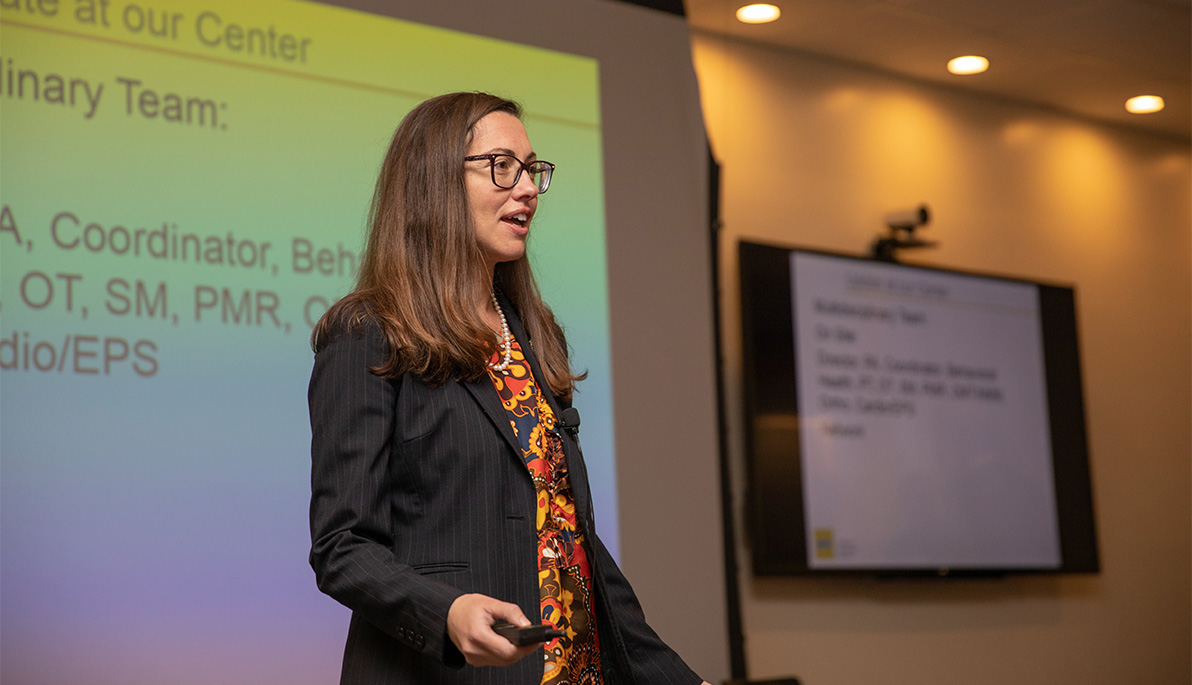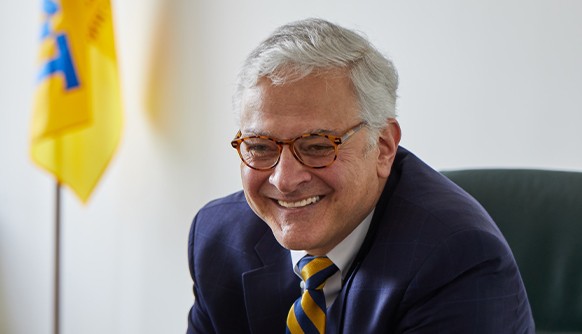News
Understanding Ehlers-Danlos Syndrome and Hypermobility Spectrum Disorders
November 5, 2019
Pictured: Bernadette Riley discusses the new research taking place at the Ehlers-Danlos/Hypermobility Treatment Center.
Increased flexibility is often viewed as a sign of physical fitness, but for patients with Ehlers-Danlos Syndrome (EDS) or other hypermobility spectrum disorders, it can be a detriment.
These conditions can cause one’s joints to dislocate so often that braces or splints are required for daily activities. Now, researchers at NYIT School of Health Professions and NYIT College of Osteopathic Medicine are uncovering new information to help improve the quality of life for EDS patients.
One out of 5,000 individuals worldwide is affected by EDS. It is a rare group of hypermobility spectrum disorders (conditions where joints easily move beyond the normal range of motion) that affect the connective tissues supporting the skin, bones, blood vessels, and other organs. While healthy patients have connective tissue made of sturdy collagen, which allows the tissue to be stretched to its limit and then safely returned to its normal position, patients with EDS have fragile connective tissue with insufficient or faulty collagen. EDS can be life-threatening if blood vessels or heart tissue are affected.
The disease is currently classified into 13 subtypes, characterized by various symptoms such as hypermobility, skin elasticity, and others. Now, the Marfan Foundation, a U.S. non-profit organization that funds research on connective tissue disorders, has awarded a team of New York Institute of Technology researchers, led by Joanne Donoghue, Ph.D., associate professor and director of clinical research at NYITCOM, funding to investigate the impact of Hypermobile EDS (hEDS) on the gastrointestinal system.
Of the 12 EDS subtypes, hEDS is the only subtype with an undetermined cause and is considered to be the most extreme disorder on the hypermobility spectrum. The condition may also cause changes to the collagen in digestive tissue, interfering with the body’s natural ability to absorb nutrients and minerals and causing bone density to weaken. The $100,000 two-year grant will examine whether affected intestinal connective tissue could be a potential risk factor for reduced bone density.
“Hypermobile EDS subtype is the most common subtype we see at our clinic, and is the only EDS subtype that does not have a genetic component associated with it,” said Bernadette Riley, D.O., director of New York Institute of Technology’s Ehlers-Danlos/Hypermobility Treatment Center. “Now, for the first time, we have an opportunity to explore the gastrointestinal impacts of this condition, in the hopes of improving treatment options and quality of life for our patients.”
Other researchers also hope to uncover additional insight on hEDS and have recently received grants from the university to fund their work. Amber Sousa, Ph.D., assistant professor of osteopathic manipulative medicine at NYITCOM, is leading a study to explore the emotional and thinking challenges associated with hEDS, which have not yet been fully studied, and Veronica Southard, D.H.Sc., associate professor of physical therapy is leading a study on outcome measures for persons with hEDS.
In addition to this funding, Todd Cohen, M.D., NYITCOM professor and chief of cardiology and director of medical device innovation, has published a study with Riley and fellow NYITCOM researchers titled, “Cardiology and Electrophysiology Considerations of Ehlers-Danlos Syndrome and Variants, Including Hypermobile Syndromes.” The study, which appears in the November 2019 issue of EP Research, suggests that depending on the patient‘s symptoms and severity, as well as abnormal cardiac findings, electrophysiology studies, or tests that assess the heart’s electrical system or activity, may prove useful but may not be necessary in many patients with EDS and EDS-like symptoms.
On November 1, the Ehlers-Danlos/Hypermobility Treatment Center held its annual symposium. Riley discussed the research efforts taking place, and presenters addressed areas such as osteopathic manipulative treatment for EDS, physical and occupational therapy interventions, community resources, and the cardiovascular effects of EDS. In addition to Cohen, Riley, and Sousa, Andrea Coladner, D.O., assistant professor of family medicine, and Jack Comeau, D.P.T., physical therapist and supervisor of rehabilitation at the Academic Health Care Center, addressed attendees.





